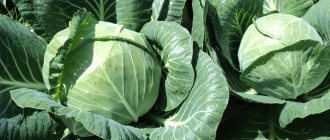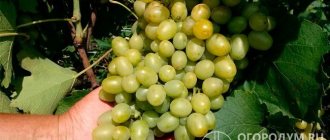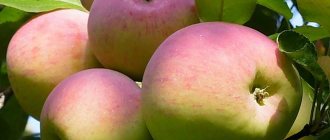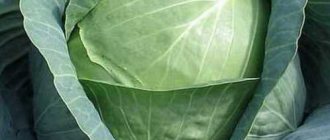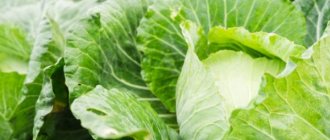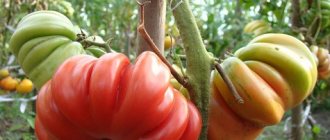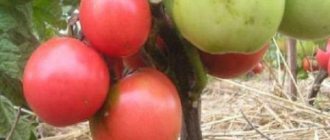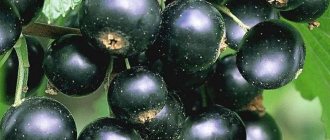- Landing
In recent years, “Aggressor” cabbage has been confidently conquering the garden beds of vegetable lovers. This relatively new hybrid has valuable features - it does not suffer from fusarium, is not afraid of thrips invasion, easily tolerates difficult weather conditions and allows you to obtain a high yield of marketable products with good taste.
Heads of cabbage that ripen in the mid-late period are intended for fresh consumption and the preparation of any dishes, suitable for pickling
A brief description of the “Aggressor” cabbage variety, or rather the hybrid, is given in the table:
| Parameter | Characteristic |
| Culture | White cabbage (Brassica oleracea L. convar. capitata (L.) Alef. var. alba DC.) |
| Variety/hybrid | "Aggressor F1" (first generation hybrid) |
| The period from germination to the beginning of technical ripeness | According to the State Register - 130-150 days; according to the originator – 115-120 days |
| Ripening period | Mid-late |
| Productivity | Marketable – 431-650 c/ha, maximum – 800 c/ha |
| Head weight | 2.5-3 kg (up to 5 kg) |
| Appearance | Medium size, round shape, dense; covering leaves with a waxy coating, have an anthocyanin tint |
| Taste qualities | Good |
| Purpose | Commodity production; used for fresh consumption and processing |
| Shelf life | 3-5 months |
| Sustainability | Resistant to fusarium wilt and thrips damage |
| Year of registration in the State Register of the Russian Federation | 2003 |
| Recommended growing regions | Central Black Earth, Central, Northwestern, North Caucasian, Volga-Vyatka, Lower Volga, Middle Volga, Far Eastern, West Siberian, Ural, East Siberian |
| Originator | Syngenta Seeds BV (Netherlands) |
Characteristics of the variety
The variety received its name due to its resistance when grown in unfavorable climates and even on soils poor in nutrients. Culture has been zoned for almost any region. The exception is the northern part of Russia. The hybrid gained popularity due to its abundant fruiting and attractive presentation.
Aggressor cabbage, the variety description and photo of which is presented, belongs to the medium-late ripening types. The average period for heads of cabbage to acquire technical maturity is 130-150 days. The stable harvest volume reaches 430-650 centners per 1 hectare of plantings. The percentage of obtaining marketable vegetables is close to 92-96%.
Harvesting begins in the second half of September - early October, depending on the region. Determine the readiness of the heads of cabbage by touch - hard and dense vegetables must be harvested. Interestingly, due to its high cold resistance, ripe cabbage, remaining in the garden, easily tolerates a temperature drop to -7℃, but the collected heads of cabbage freeze and spoil under the same conditions.
Description of cabbage variety Aggressor.
The average size of a head of cabbage reaches 2.5-3 kg. Round, slightly flattened fork with a highly dense arrangement of leaves. The leaf rosette raised above the soil is extensive. The outer leaves are grayish-green with a bluish tint. Medium-sized leaf blades with a slightly wavy edge are covered with a waxy coating. When cut, the head of cabbage has a whitish-yellow hue.
The taste is universal, with a low sugar content. Poured crispy leaves are convenient for preserving and preparing fresh dishes. The fruits are stored in a cool, dry place for up to six months.
Heads of cabbage collected during the onset of cool, dry weather last longer. During the collection process, it is necessary to cut off the head of cabbage, preserving the lower leaves and a small stump. Before storing, you should sort the heads of cabbage according to their density. The loosest fruits are consumed first or used for preservation.
Advantages and disadvantages of the variety
Despite the fact that this is a relatively young variety, it has become one of the most cultivated today. The Aggressor managed to achieve this position due to a large number of advantages. In particular, the advantages of Aggressor F1 include:
- Excellent taste.
- Heads of cabbage are not prone to cracking during cabbage storage.
- The leaves are very juicy and crunchy well.
- Aggressor F1 contains a large amount of vitamin C, which makes it possible to include it in the diet of young children or use cabbage as a dietary product.
- High commodity value.
- The aggressor has a powerful root system.
- It can easily be transported over long distances, which makes cabbage attractive for commercial use.
- Aggressor F1 is characterized by uniform harvest ripening.
- The germination rate of seeds of this variety reaches 100%.
- Unlike many other cabbage varieties, Aggressor tolerates short periods of water shortage well.
- Normally tolerates elevated temperatures that occur when cultivating crops in the southern regions.
- It is also not afraid of low temperatures.
- Aggressor F1 is one of the most highly productive cabbage varieties.
In addition, it is worth noting a number of other advantages. Aggressor is a universal variety. Cabbage is suitable for consumption raw; it can be used to prepare salads, stews, etc. In addition, the vegetable can be fermented for the winter.
Typically, heads of cabbage are stored for up to 5 months. Under ideal conditions, the shelf life can be increased to 6-6.5 months.
At the same time, one should not turn a blind eye to the Aggressor’s shortcomings. The disadvantages of this variety include:
- Sometimes heads of cabbage grow with rather hard leaves. These are isolated cases, but alas, they do occur.
- During pickling, an unpleasant bitterness may appear.
- The crop is not protected from aphids and whiteflies.
Preparation of planting material and propagation
Cabbage is cultivated using the seedling method. Only in the southern regions is it permissible to sow seeds directly into open ground. Preparing seedlings speeds up the ripening process of the crop, despite the more labor-intensive preparation process.
Preparing seeds for direct planting
Seeds that are known to be unsuitable must be discarded. First, select seeds larger than 1.5 mm and incubate them for 20 minutes in hot water (50℃). Then place it in cold water for 2 minutes and then dry it. After drying, the seeds are ready for planting in the beds.
Preparing seeds for seedlings
To sow seeds for seedlings, it is also necessary to select the largest samples. They are kept in hot water (50℃) for 20 minutes, after which they are hardened for 2-3 minutes in cold water. After this, the seeds should be soaked in a growth stimulator, for example, Epin Extra for half an hour, drying after treatment.
A ready-made soil mixture or soil prepared independently is suitable as a substrate. To do this, you will need to combine turf, podzolic peat and river sand in a ratio of 1/4/2. The use of individual peat pots will help facilitate the process of further transfer of seedlings.
- Plant the seeds in the ground, deepening them no more than 1.5 cm.
- Cover the top with a thin layer of earth and irrigate with a spray bottle.
- Fresh plantings require careful monitoring of soil moisture. Drying out will lead to the death of plants, while stagnation of water will provoke root rot.
- After sprouting, the seedlings are placed in a sunny place. In the absence of good lighting, add additional light using a phytolamp.
After the formation of the first 2 true leaves, the seedlings must be watered with a mixture diluted in 1 liter of water, which contains:
- ammonium nitrate (2.5 g);
- potassium chloride (1 g);
- superphosphate (4 g).
After another 2 weeks, the seedlings should be fed with a solution of ammonium nitrate, dissolving 3 g in 1 liter of water. 2-3 days before transferring to unprotected soil, seedlings should be fertilized with a mixture of potassium chloride (2 g), ammonium nitrate (3 g) and superphosphate (8 g), diluted in 1 liter of water.
Liquid fertilizer should be applied at the rate of 1 cup per plant, avoiding liquid getting on the leaves. 1.5 weeks before transplanting, seedlings must be hardened off. You should start with airing for a few minutes, and end with taking the sprouts out into the open air.
Reviews from vegetable growers
Ivan, 46 years old, Rostov region
I ordered the seeds online. The description stated that this is a Dutch variety that gives a good harvest, does not suffer from fusarium, and is suitable for pickling and for eating fresh. I became interested, bought it and planted it. What can I say, cabbage is really good. The heads of cabbage are smooth, beautiful, weigh about 3 kg, but there are also larger ones. There was no pain, no cracking. I collected a pretty good harvest, part of it was salted, and the rest was put in the basement, let's see how it will be stored.
Victor, 45 years old, Kazan
This year the Aggressor planted for the first time. Seeds were sown in early June in open ground. The heads of cabbage have grown very well, beautiful, dense, some weigh more than 5 kg, but on average about 3-3.5 kg. I hope that my harvest will last until spring. Next year I plan to plant not only for myself, but also for sale.
Irina, 42 years old, Moscow region
I planted Aggressor at the end of May. But then we started having very heavy rains, and some of the sprouts disappeared. The rest were attacked by slugs and eaten the leaves. But the heads of cabbage still started and grew. Even though I didn’t water it at all in the summer. Harvested in October. I weighed the largest head of cabbage, its weight turned out to be almost 6 kg, the rest were smaller - from 2.5 to 4.5 kg. None of them cracked. I think that the variety is good, persistent, grows no matter what, I recommend it to everyone for planting.
Preparing the soil and planting site
Aggressor cabbage (a description of the variety and photos of plantings are attached) will give a rich harvest if it is planted in the most illuminated place. The soil can be slightly acidic or neutral. Shading of cabbage beds leads to increased growth of tops and poor fork formation.
According to the rules of crop rotation, it is extremely important that the previous crops in this place are not other varieties of cabbage, turnips, radishes or radishes. In the listed crops, similar diseases and pests dormant in the soil can also affect the Aggressor variety. Cabbage is successfully cultivated on the site of the previous growth of beans, cucumber varieties, bulbous crops and tomatoes.
The ideal time to prepare beds is autumn. Fertilizers applied to the soil have time to dissolve and become more accessible to cabbage seedlings. If it is not possible to prepare the site in the fall, it is permissible to prepare the soil in the spring, allowing it to sit for 2-3 weeks before planting the seedlings.
The soil must be dug up using a shovel or processed using a motor cultivator. Clear the soil of stones, old rhizomes, small pebbles, and other debris. Organic fertilizers, humus or peat are added to well-prepared soil at the rate of 6 kg per 1 sq. m of soil.
Then dry mineral fertilizers are added. This can be superphosphate, urea in a ratio of 1/1 at the rate of 30 g per 1 square meter. m. From the prepared soil, beds are formed with holes at a distance of 50 cm between adjacent plants and 70 cm between rows.
Growing Cabbage Aggressor
During the growing season, Aggressor F1 cabbage needs:
- in the morning or evening watering with settled water at least once a week;
- weeding and loosening the soil;
- in fertilizing with nitrogen and mineral fertilizers.
If you follow simple rules of agricultural technology, you can quite count on a good cabbage harvest.
Landing algorithm
Depending on the method chosen, planting cabbage varies slightly.
Planting seedlings
You should start transferring seedlings in early May; in the northern regions, the dates are shifted until early June. Despite the cold resistance of seedlings, plants will not be able to take root while maintaining stable sub-zero temperatures during the daytime.
- The seedlings are transferred to the prepared holes, carefully removing them from the containers along with the earthen lump.
- Plant, deepening to the first leaf.
- Pour at least 0.5 liters of water into the hole and protect the root area with covering material or spruce branches for the first 2-3 days.
Further care consists of systematic watering, fertilization and treatment against parasites and infections.
Non-seedling planting method
Preparatory work with the soil for forming beds when sowing seeds openly does not differ from the seedling method. Only the landing dates are shifted to the last ten days of April.
- Place 2 seeds in each hole.
- The depth of the seeds should not be more than 1 cm.
- Then sprinkle a thin layer of soil on top and irrigate with a spray bottle.
- At the end of planting, you should cover the places with seeds with film material, regularly checking the degree of soil moisture. After the seedlings peck, the shelter is removed.
- After their germination, the most developed plant is left.
- The second sprout is removed by cutting it off at the root.
Tips and reviews from experienced gardeners
Gardeners growing Aggressor F1 note the high yield of the hybrid, good keeping quality of heads of cabbage and versatility of use.
Alexander, Kazan: “The cabbage hybrid Aggressor showed excellent results. It has a high yield; not a single head of cabbage was less than 3 kg. Aggressor F1 stores perfectly, especially when compared with other hybrids. If you keep the temperature within +3...+5°C, the heads of cabbage will lie quietly for at least six months, and nothing will happen to them.”
Semyon, Rostov-on-Don: “I have often heard that Aggressor F1 is very tough and hard, so summer residents do not want to grow it. But my family and I really liked this cabbage. Of course, the leaves are a little harsh, but you can cook anything from them. Cabbage is suitable for pickling, borscht, and cabbage rolls. The germination rate is high, and the Aggressor is stored until spring if you put it in the cellar.”
Care
The Aggressor variety has high growth vigor and is not demanding in care, but it also requires minimal attention during the growing season.
Spraying and watering
Moisture-loving cabbage needs intensive moisture during the growing season. According to the gardeners' description, the lack of watering leads to bolting, which can be seen in the photo. And also the lack of sufficient moisture inhibits the process of tying the fork.
When planting seedlings, watering is carried out every 2-3 days. As the seedlings take root and grow, the interval increases to 5 days. When a dry period occurs, watering should be more frequent. However, the appearance of stagnant water leads to the development of fungal infections.
Equipping the beds with a drip irrigation system helps to facilitate the process of supplying moisture. After moistening, it is necessary to provide the root system with oxygen. Soil aeration is carried out by loosening and weeding weeds.
Mulching helps maintain soil moisture and slow down the growth of weeds. However, slugs may live in the mulch layer, preferring to feed on succulent leaves. When this problem occurs, it is necessary to remove all mulch.
Despite the lack of tendency to cracking, watering must be stopped a month before harvesting. It is not recommended to rain the plantings due to the possible dominance of insect pests, in particular slugs.
Top dressing
Fertilizers applied during the preparation of beds are able to ensure the development of plants. However, additional fertilizing has a positive effect on the overall yield.
21 days after transplanting the seedlings, the first additional fertilizing should be applied in the form of a solution of urea or ammonium nitrate. 10 g of fertilizers are dissolved in one bucket of water and watered at the rate of 200 ml per future head of cabbage.
The process of heading formation can be stimulated. To do this, dilute 10 g of potassium monophosphate in 10 liters of water and water the plants, adding 200 ml per crop.
Hilling
Aggressor cabbage (variety description and photos help gardeners achieve good harvests), like any other variety, prefers hilling. An agrotechnical technique allows you to stimulate the development of adventitious roots, thereby enhancing growth.
- In calm weather, 20 days after planting the seedlings, it is necessary to loosen the soil to a fine-grained structure.
- Carefully collect the soil and create a raised area around the stem, no more than 30 cm high.
- Sprinkle between rows with sifted wood ash or mustard powder to repel pests.
- Every other day, strengthen the inter-row space by placing sawdust or dry grass in the trenches.
Hilling should be carried out once. The procedure can be repeated only if the soil subsides by more than 10 cm.
Optimal conditions
The best conditions for cabbage of the Aggressor variety are to maintain an irrigation regime. Since the variety is undemanding to environmental factors, even nutrient-depleted soils are suitable for cultivation.
Frost resistance allows the variety to be cultivated in northern regions, since the crop can withstand temperature drops to sub-zero values. The only necessary condition for obtaining a rich harvest of strong heads of cabbage is the presence of sufficient lighting.
By planting cabbage in the shade or with the beds shaded for most of the day, you will get a crop of loose and weak heads of cabbage with large leaves that is unsuitable for preservation.
The struggle for the harvest requires different measures:
- It is necessary to ensure that there is no lack of magnesium and potassium in the soil.
- The lack of zinc and boron should be constantly replenished.
- Increase the humus content above 2.5%.
- Avoid overcooling and drying out the soil.
Harvest and storage
Cabbage ready for harvest is distinguished by the elasticity of its heads, its size and shiny leaves. They are cut off with a knife or an ax, leaving a stalk 3-4 cm long.
How and when to collect
Since Aggressor cabbage has a medium-late ripening period, the collection of heads of cabbage begins in late September - early October. By this time they reach full maturity. They are harvested in dry weather at a daytime temperature no higher than +8°C.
Storage features and shelf life
Fully healthy heads of cabbage, without signs of damage or disease, are subject to long-term storage. They are placed in a basement or cellar in 2-3 rows or hung on slats by the stalks. The storage area must be ventilated.
Important! The optimal temperature for storing vegetables is +1…+5°C. The humidity in the room where plugs are stored must be at least 90%. You should avoid exposure to light, otherwise the cabbage will begin to sprout.
When optimal conditions are created, cabbage can be stored for up to 6 months without losing its quality.
Possible diseases and pests, ways to get rid of them
Despite the genetic resistance to fusarium, other fungal infections can affect the Aggressor variety.
| Diseases and pests | Picture of defeat | Control measures |
| Kila | A fungal disease whose pathogen lives in the soil layer. Affected plants take on a bluish-green tint, becoming loose and limp. Ball-shaped growths form on the roots, leading to rotting and cracking of the forks. | As a preventive measure, seed treatment with Granosan is necessary before planting. When transferring seedlings, the roots should be dipped in a clay mash. If the plants are already affected, they cannot be cured. Diseased specimens must be uprooted and destroyed. |
| Blackleg | A fungal infection that develops in conditions of excessive soil moisture. First, the roots turn black, become limp, and then rot. | Prevention of blackleg is to incubate the roots in potassium permanganate before planting in unprotected soil. |
| Downy mildew or peronosporosis | It affects seedlings grown in a greenhouse. Yellow spots with a gray coating appear on the leaves | Treatment with Bordeaux mixture at a rate of 20 ml per plant will help get rid of the infection. |
| Mole | The moth lays eggs on the inside of the leaf. | You should get rid of the invasion by treating with calcium arsenate or Entobacterin solution. |
| Aphid | They settle in colonies and feed on cell sap. The leaves become pale pink and limp. | To get rid of aphids, treatment with a soda-soap solution or whey is suitable. |
| Cabbage fly larvae | Perforate the root system, making it difficult for the plant to feed | The treatment is to sprinkle the beds with a mixture of tobacco, wood ash and red pepper. For 1 sq. m, it is enough to pour 1 tbsp. l. tobacco or 10 g pepper. |
| Rapeseed whiteweed caterpillars | Eat cabbage leaves | In the fight against the pest, plantings should be treated with chlorophos or calcium arsenate. |
| Snails and slugs | They feed on cabbage leaves, leaving a specific mark. | The granular preparation Thunder or Meta will help to scare off the pests. 3-4 tablets of the drug are placed under each bush. |
For any plant damage, it is recommended to use safe folk recipes. Commercial preparations tend to remain in the plant cells.
Crop rotation is no less important - spores of pathogenic fungi, eggs and larvae of pests gradually accumulate in the soil. With excessive thickening of plantings, any disease spreads much faster. Various diseases can occur in cabbage at any stage of development. But young seedlings are considered the most susceptible.
Aggressor cabbage (the variety description and photo are useful for a beginning gardener) tolerates home pest control methods well:
- Dusting with wood ash both seedlings and growing plants.
- Infusion of tomato tops - boil 1 kg of tomato tops or tops in 3 liters of water and leave for 2-3 days. Strain the resulting solution and dilute it twice with water, adding an additional few tablespoons of liquid soap.
- Decoction of onion peels. Brew the collected onion peels in a liter jar with boiling water. After steeping for 2 days, strain and dilute with 1/2 water, adding liquid soap.
- For prevention, dilute 150 g of lime in 5 liters. Mix thoroughly and pour the resulting solution onto the bushes. Pour 0.5 liters of solution onto each.
In addition, timely weeding and maintaining a normal level of soil moisture are used as preventive measures against the spread of infections. 30 days before harvesting cabbage, the use of any chemicals is prohibited.
Peculiarities
The advantages of the Aggressor variety include:
- excellent growth vigor and high yield;
- resistance to fusarium and immunity to cruciferous flea beetle attacks;
- ease of care;
- ability to withstand temperature changes;
- juicy, pleasant taste;
- no tendency to crack;
- unpretentiousness to growing conditions;
- high seed germination;
- good transport tolerance;
- long shelf life.
No objective negative qualities were observed in the variety. However, some gardeners note that the leaves are tough, rough and bitter, which manifests itself when pickling. The listed disadvantages may be a consequence of non-compliance with agrotechnical recommendations. The most serious drawback is that it often suffers from fungal diseases, especially suffering from clubroot.
Aggressor cabbage is one of the most cold-resistant varieties. The possibility of obtaining a harvest under risky farming conditions allows the variety to be cultivated in regions with harsh climates. At the same time, the absence of difficulties in care according to the descriptions of summer residents allows even beginners to get a rich harvest of strong, juicy heads of cabbage, photographs of which can be seen on the pages of gardeners.
Origin and distribution
Cabbage "Aggressor" is a hybrid of the first generation (F1), which was created by specialists from the famous. The originator does not disclose information about the varieties that served as parent forms during breeding.
In the photo - planting material in packages of various domestic agricultural companies (AliExpress offers seeds from the Timiryazevsky nursery and the Dutch company Syngenta)
Syngenta is a large international company operating in the field of agribusiness, one of the leaders in the production and supply of seeds of vegetable, grain and ornamental crops, as well as plant protection products. The headquarters is located in Switzerland, and is currently owned by the Chinese corporation ChemChina.
In 2001, an application was submitted to the State Variety Commission to include the Aggressor F1 hybrid in the register of selection achievements. In the course of standard field tests, by 2003, a new variety of crop was zoned in the Central region. Currently, this cabbage is recommended for cultivation throughout almost the entire territory of Russia.
Cabbage from the category of modern hybrids is successfully grown by both large vegetable producers and amateur gardeners
F1 hybrids are highly valued in the world. Compared to conventional varieties, they have improved yields, marketability, transportability, resistance to diseases and adverse factors. Hybrid forms are obtained by crossing varieties with different valuable traits. As a result, the phenomenon of heterosis is observed, that is, the descendants of the first generation (F1) are superior to the parent plants in certain or several characteristics. They do not inherit a stable combination of genes - in the second and subsequent generations, heterosis decreases sharply. Therefore, it makes no sense to collect “your” seeds from F1 hybrids for further cultivation .
